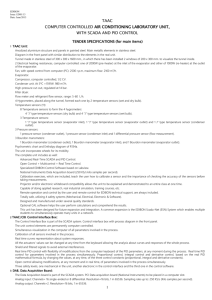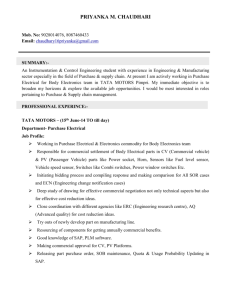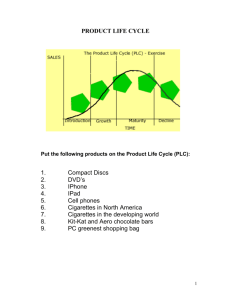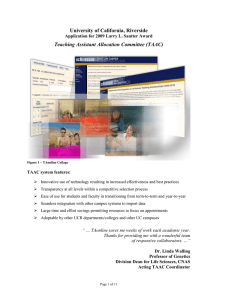TAAC Computer Controlled Air Conditioning Laboratory Unit
advertisement
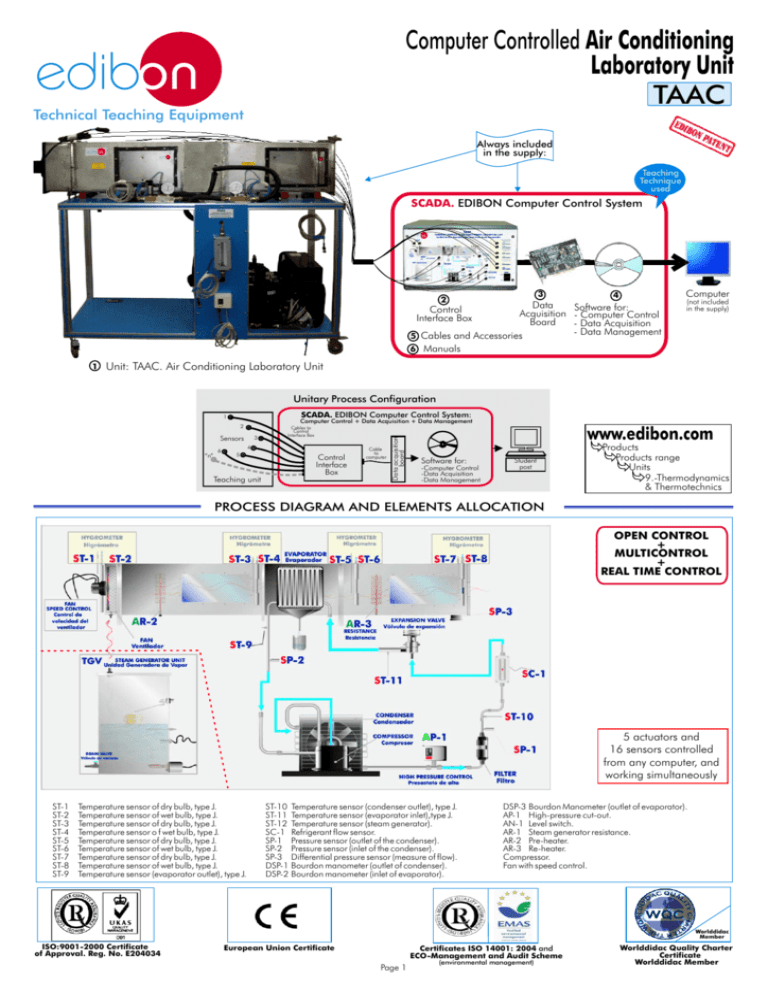
Computer Controlled Air Conditioning Laboratory Unit TAAC Technical Teaching Equipment Always included in the supply: Teaching Technique used SCADA. EDIBON Computer Control System 3 2 Data Control Acquisition Interface Box Board 5 Cables and Accessories 6 Manuals 1 Computer 4 Software for: - Computer Control - Data Acquisition - Data Management (not included in the supply) Unit: TAAC. Air Conditioning Laboratory Unit Unitary Process Configuration SCADA. EDIBON Computer Control System: 1 Sensors “n” 6 3 Cables to Control Interface Box 4 5 Control Interface Box Teaching unit Cable to computer Data acquisition board Computer Control + Data Acquisition + Data Management 2 www.edibon.com Software for: -Computer Control -Data Acquisition -Data Management Student post Products Products range Units 9.-Thermodynamics & Thermotechnics PROCESS DIAGRAM AND ELEMENTS ALLOCATION OPEN CONTROL + MULTICONTROL + REAL TIME CONTROL 5 actuators and 16 sensors controlled from any computer, and working simultaneously ST-1 ST-2 ST-3 ST-4 ST-5 ST-6 ST-7 ST-8 ST-9 Temperature sensor of dry bulb, type J. Temperature sensor of wet bulb, type J. Temperature sensor of dry bulb, type J. Temperature sensor o f wet bulb, type J. Temperature sensor of dry bulb, type J. Temperature sensor of wet bulb, type J. Temperature sensor of dry bulb, type J. Temperature sensor of wet bulb, type J. Temperature sensor (evaporator outlet), type J. ST-10 Temperature sensor (condenser outlet), type J. ST-11 Temperature sensor (evaporator inlet),type J. ST-12 Temperature sensor (steam generator). SC-1 Refrigerant flow sensor. SP-1 Pressure sensor (outlet of the condenser). SP-2 Pressure sensor (inlet of the condenser). SP-3 Differential pressure sensor (measure of flow). DSP-1 Bourdon manometer (outlet of condenser). DSP-2 Bourdon manometer (inlet of evaporator). DSP-3 Bourdon Manometer (outlet of evaporator). AP-1 High-pressure cut-out. AN-1 Level switch. AR-1 Steam generator resistance. AR-2 Pre-heater. AR-3 Re-heater. Compressor. Fan with speed control. Worlddidac Member ISO:9001-2000 Certificate of Approval. Reg. No. E204034 European Union Certificate Certificates ISO 14001: 2004 and ECO-Management and Audit Scheme Page 1 (environmental management) Worlddidac Quality Charter Certificate Worlddidac Member SPECIFICATIONS Items supplied as standard 1 TAAC. Unit: This unit has as objective to introduce the student in the world of the air conditioning installations, as well as to study and determine the good parameters for the unit operation in function of the environmental demands (humidity, heat, temperature and refrigeration, etc). Anodized aluminium structure and panels in painted steel. Main metallic elements in stainless steel. Diagram in the front panel with similar distribution that the elements in the real unit. Tunnel of 300 x 300 x 1600 mm. , made in stainless steel with 2 windows of 200 x 300 mm. to visualize the tunnel inside. 2 Electrical heating resistances (computer controlled): one of 2000W (pre-heater) to the inlet of the evaporator and other of 1000 W (re-heater) to the outlet of the evaporator. 4 Hygrometers placed along the tunnel, formed each one by 2 temperature sensors (wet and dry bulb). Fan, with speed control from computer, 0.25KW, 2500 r.p.m, Qmax 2160 m3/h. Evaporator. Compressor, 1/2 CV. Condenser unit. At 5oC =1591W. 980 m3/h. High-pressure cut-out, tared at 14 bar. Filter dryer. Flow meter and refrigerant flow sensor, range: 5-60 l./h. Temperature sensors (11): 4 dry bulb “J” type, 4 wet bulb “J” type, 1 “J” type (inlet of the evaporator), 1 “J” type (outlet of the evaporator), 1 “J” type(outlet of the condenser). Sensors range: -40 to 750o C. Pressure sensors (3): 1 sensor (outlet of the condenser), 1 sensor (inlet of the condenser), 1 differential sensor (measure of flow). Bourdon manometers (3): 1 bourdon manometer (outlet of the condenser), 1 bourdon manometer (inlet of the evaporator),1 bourdon manometer (outlet of the evaporator). Psychometric chart and Enthalpy diagram of R134a. The unit incorporates wheels for mobility. TAAC Unit 2 TAAC/CIB. Control Interface Box : Control interface box with process diagram in the front panel and with the same distribution that the different elements located in the unit, for an easy understanding by the student. All sensors, with their respective signals, are properly manipulated for -10V. to +10V computer output. Sensors connectors in the interface have different pines numbers (from 2 to 16), to avoid connection errors. Single cable between the control interface box and computer. The unit control elements are permanently computer controlled, without necessity of changes or connections during the whole process test procedure. Simultaneously visualization in the computer of all parameters involved in the process. Calibration of all sensors involved in the process. Real time curves representation about system responses. Storage of all the process data and results in a file. Graphic representation, in real time, of all the process/system responses. All the actuators’ values can be changed at any time from the keyboard allowing the analysis about curves and responses of the whole process. All the actuators and sensors values and their responses are placed in only one computer screen. Shield and filtered signals to avoid external interferences. Real time PID control with flexibility of modifications from the computer keyboard of the PID parameters, at any moment during the process. Real time PID and on/off control for pumps, compressors, resistances, control valves, etc. Real time PID control for parameters involved in the process simultaneously. Proportional control, integral control and derivative control, based on the real PID mathematical formula, by changing the values, at any time, of the three control constants (proportional, integral and derivative constants). Open control allowing modifications, at any time and in a real time , of parameters involved in the process simultaneously. Possibility of automatization of the actuators involved in the process. Three safety levels, one mechanical in the unit, other electronic in control interface and the third one in the control software. 3 DAB. Data Acquisition Board: PCI Data acquisition board (National Instruments) to be placed in a computer slot. Bus PCI. Analog input: Number of channels= 16 single-ended or 8 differential. Resolution=16 bits, 1 in 65536. Sampling rate up to: 250 KS/s (Kilo samples per second). Input range (V)= ±10V. Data transfers=DMA, interrupts, programmed I/0. DMA channels=6. Analog output: Number of channels=2. Resolution=16 bits, 1 in 65536. Maximum output rate up to: 833 KS/s. Output range(V)=±10V. Data transfers=DMA, interrupts, programmed I/0. Digital Input/Output:Channels=24 inputs/outputs. D0 or DI Sample Clock frequency: 0 to 1 MHz. Timing: Counter/timers=2. Resolution: Counter/timers: 32 bits. 4 TAAC/CIB DAB TAAC/CCSOF. Computer Control+Data Acquisition+Data Management Software: Compatible with actual Windows operating systems. Graphic and intuitive simulation of the process in screen. Compatible with the industry standards. Registration and visualization of all process variables in an automatic and simultaneously way. Flexible,open and multicontrol software, developed with actual windows graphic systems, acting simultaneously on all process parameters. Analog and digital PID control. Menu for PID and set point selection required in the whole work range. Management, processing, comparison and storage of data. Sampling velocity up to 250,000 data per second guaranteed. Student calibration system for all sensors involved in the process. It allows the registration of the alarms state and the graphic representation in real time. Comparative analysis of the obtained data, after to the process and modification of the conditions during the process. Open software, allowing to the teacher to modify texts, instructions. Teacher’s and student’s passwords to facilitate the teacher’s control on the student, and allowing the access at different work levels. This unit allows that the 30 students of the classroom can visualize simultaneously all results and manipulation of the unit, during the process, by using a projector. 5 Cables and Accessories, for normal operation. 6 Manuals:This unit is supplied with 8 manuals: Required Services, Assembly and Installation, Interface and Control Software, Starting-up, Safety, Maintenance, Calibration & Practices Manuals. TAAC/CCSOF 1 to 6: TAAC + TAAC/CIB + DAB + TAAC/CCSOF + Cables and Accessories + Manuals are included in the *References minimum supply, enabling a normal operation. Continue... Page 2 www.edibon.com SPECIFICATIONS Complementary items to the standard supply PLC. Industrial Control using PLC (7 and 8): 7 PLC-PI. PLC Module: Circuit diagram in the front panel. Front panel: Digital inputs(X) and Digital outputs (Y) block: 16 Digital inputs, activated by switches and 16 LEDs for confirmation (red). 14 Digital outputs (through SCSI connector) with 14 LEDs for message (green). Analog inputs block: 16 Analog inputs (-10V. to + 10V.)( through SCSI connector). Analog outputs block: 4 Analog outputs (-10V. to + 10V) (through SCSI connector). Touch screen: High visibility and multiple functions. Display of a highly visible status. Recipe function. Bar graph function. Flow display function. Alarm list. Multi language function. True type fonts. Back panel: Power supply connector. Fuse 2A. RS-232 connector to PC. Inside: Power supply outputs: 24 Vdc, 12 Vdc, -12 Vdc, 12 Vdc variable. Panasonic PLC: High-speed scan of 0.32 msec. for a basic instruction. Program capacity of 32 Ksteps, with a sufficient comment area. Free input AC voltage(100 to 240 V AC). DC input:16 (24 V DC). Relay output: 14 (250 V A AC/2 A). High-speed counter. Multi-point PID control. Digital inputs/outputs and analog inputs/outputs Panasonic modules. Communication RS232 wire, to computer (PC). 8 PLC-PI TAAC/PLC-SOF. PLC Control Software: For this particular unit, always included with PLC supply. Items available on request 9 10 TAAC/CAL. Computer Aided Learning Software (Results Calculation and Analysis). TAAC/FSS. Faults Simulation System. Page 3 www.edibon.com EDIBON Computer Control System Software Main Screens Main screen Note: ST=Temperature sensor. SP= Pressure sensor. AR=Heating resistance. Examples of Sensors Calibration screens Example of PID controls screen Continue... Page 4 www.edibon.com EDIBON Computer Control System Some typical exercises results Actions: 1.-Starting up the steam generator. Effects: (changes marked with red dots) -Temperature is starting to raise in the steam generator. Actions: 1.-Steam generation is going up to 99.5ºC. 2.-We start the fan, from position “0” to position “5”. Effects: (changes marked with red dots) -Air Flow is raising to 20 litres/second. -Temperature changes in several ST sensors. -Pressure changes in SP sensors. -Flow changes in SC-1 sensor. -The open control, multicontrol and real time control system is used. Actions: 1.-Steam is generating. 2.-Fan is working now at maximum speed, position “10”. 3.-Starting up the compressor. Effects: (changes marked with red dots) -The outlet temperatures in ST-5/ 6/ 7/ 8 sensors are going down. -The temperatures of the input air in ST-3 and ST-4 sensors are raising. -Pressure changes in SP sensors. -Flow changes in SC-1 sensor. -The open control, multicontrol and real time control system is used. Page 5 www.edibon.com EXERCISES AND PRACTICAL POSSIBILITIES Some Practical Possibilities of the Unit: 1.- Demonstration of the processes and components used in heating, cooling, humidification, de-humidification of an airstream. 2.- Obtaining of the steam generator efficiency curve. 3.- Energy balance in the steam generator. 4.- Efficiency determination of the preheating resistance. 5.- Preheating effect in an air conditioning installation. 6.- Dehumidification process study. 7.- Material balance in the evaporator. 8.- Energy balance in the evaporator. 9.- Re-heat effect. 10.- Experimental determination of the air specific heating capacity. Other possible practices: 11.- Psychrometric chart. 12.- Example of the air properties determination. 13.- Usage of psychrometric chart. 14.- Determination of the airflow. 15.- Temperature sensors calibration. 16.- Pressure sensors calibration. 17.- Determination of a PWM controller adjustment parameters. 18.- Properties of the Refrigerant R134a. 19.- Enthalpy-Pressure diagram for the refrigerant R134a. Practices to be done by PLC Module (PLC-PI)+PLC Control Software: 20.- Control of the TAAC unit process through the control interface box without computer. 21.- Visualization of all the sensors values used in TAAC unit process. 22.- Calibration of all sensors included in TAAC unit process. 23.- Hand on of all the actuators involved in the TAAC unit process. 24.- Realization of different experiments, in automatic way, without having in front the unit. (This experiment can be decided previously). 25.- Simulation of outside actions, in the cases do not exist hardware elements (Example: test of complementary tanks, complementary industrial environment to the process to be studied, etc). 26.- PLC hardware general use and manipulation. 27.- PLC process application for the TAAC unit. 28.- PLC structure. 29.- PLC inputs and outputs configuration. 30.- PLC configuration possibilities. 31.- PLC program languages. 32.- PLC different programming standard languages (literal structured, graphic, etc.). 33.- New configuration and development of new process. 34.- Hand on an established process. 35.- To visualize and see the results and to make comparisons with the TAAC unit process. 36.- Possibility of creating new process in relation with the TAAC unit. 37.- PLC Programming Exercises. 38.- Own PLC applications in accordance with teacher and student requirements. POSSIBILITIES OF OTHER AVAILABLE EXPANSIONS Expansion 1: 11 Mini ESN. Multipost EDIBON Mini Scada-Net System Expansion 2: Teaching Technique used 12 ESN. Teaching Technique used Multipost EDIBON Scada-Net System “n” 1 UNIT = 30 STUDENTS can work simultaneously Air Conditioning Laboratory Unit (TAAC) Computer Control Software: Computer Control Control Interface Box Data Acquisition+ Data Management Any other additional computer controlled unit Refrigeration Cycle Demonstration Unit (TCRC) Heat Pump+Air Conditioning+Refrigeration Unit (Double Condenser, Double Evaporator and Cycle Inversion Valve) (THIBAR22C) (1) Air Conditioning Laboratory Unit (TAAC) (1) (1) PLC PLC Bench Top Cooling Tower (TTEC) (1) “n” (1)Control Interface (1) PLC PLC Heat Exchangers Training System (TICC) PLC “n” PLC CENTRAL PLC Teacher’s Central 30 Student Computer Post Mini Scada-Net Software “REAL TIME MULTICONTROL SYSTEMS” “SCADA” LOCAL NET 30 Student Post OPEN CONTROL + MULTICONTROL + MULTI STUDENT POST Note: The Mini ESN system can be used with any EDIBON computer controlled unit. OPEN CONTROL + MULTICONTROL + MULTI STUDENT POST CENTRAL COMPUTER LOCAL NET Option “ETDL” EDIBON TECHNICAL DISTANCE LEARNING SYSTEM 30 students can work at the same time Note: The ESN system can use any EDIBON computer controlled unit. ORDER INFORMATION Complementary items to the standard supply Items supplied as standard Minimum configuration for normal operation includes: 1 Unit: TAAC. Air Conditioning Laboratory Unit. 2 TAAC/CIB.Control Interface Box. 3 DAB.Data Acquisition Board. 4 TAAC/CCSOF. Computer Control + Data Acquisition + Data Management Software. 5 Cables and Accessories, for normal operation. 6 Manuals. PLC. Industrial Control using PLC.(7 and 8): 7 PCL-PI.PLC Module. 8 TAAC/PLC-SOF. PLC Control Software. 9 TAAC/CAL. Computer Aided Learning Software (Results Calculation and Analysis). (Available on request). 10 TAAC/FSS. Faults Simulation System. (Available on request). Expansions 11 Mini ESN. Multipost EDIBON Mini Scada-Net System. 12 ESN. Multipost EDIBON Scada-Net System. * IMPORTANT: Under TAAC we always supply all the elements for immediate running as 1, 2, 3, 4, 5 and 6. Page 6 www.edibon.com REQUIRED SERVICES DIMENSIONS & WEIGHTS Electrical supply: 220V.,1-phase + neutral + ground ,50 Hz. , or 110V., 1phase+ neutral + ground, 60Hz. and 3 CV max. EDIBON Steam Generator (TGV), or steam generator with similar characteristics. Water supply and drainage. Computer (PC). TAAC unit : -Dimensions:1600x570x1500 mm. approx. -Weight : 200 Kg. approx. Control Interface Box: -Dimensions: 490x330x310 mm. approx. -Weight: 10 Kg. approx. PLC Module (PLC-PI): -Dimensions: 490x330x310 mm. approx. -Weight: 30 Kg. approx. RECOMMENDED ACCESSORIES For refilling R134a refrigerant and maintenance, we recommend: - T/KIT1. Maintenance Kit, containing: vacuum pump, hoses and manometers. - T/KIT2. Maintenance Kit, containing: leakage detector. - R134a refrigerant ( to be acquired by the customer locally). AVAILABLE VERSIONS Offered in this catalogue: -TAAC. Computer Controlled Air Conditioning Laboratory Unit. Offered in other catalogue: -TAAB. Air Conditioning Laboratory Unit. * Specifications subject to change without previous notice, due to the convenience of improvements of the product. REPRESENTATIVE: C/ Del Agua, 14. Polígono San José de Valderas. 28918 LEGANES. (Madrid). SPAIN. Phone: 34-91-6199363 FAX: 34-91-6198647 E-mail: edibon@edibon.com WEB site: www.edibon.com Issue: ED01/09 Date: April/2009 Page 7
